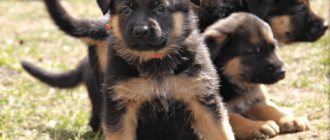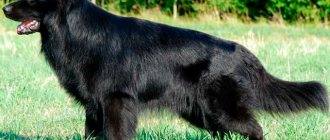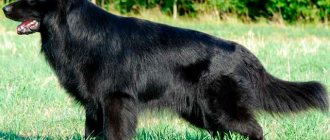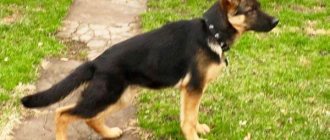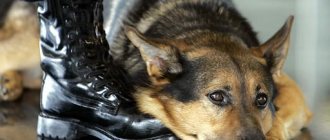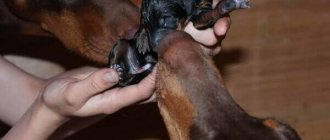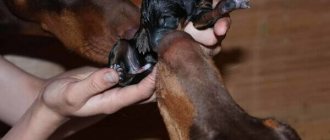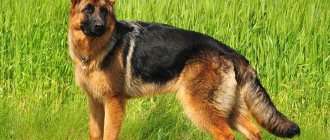In order for a German Shepherd to become a true service dog, a companion and a reliable assistant to a person, it must be properly raised and trained. The process is not easy, it requires perseverance and perseverance. Having purchased a German Shepherd puppy at the age of 1 month, you should be prepared to invest a lot of time and effort into its development before you can raise a loyal and devoted friend with a balanced character. The set goals will be achieved if you know the developmental features of a German at any age, properly maintain and lovingly care for him.
Description of the German Shepherd breed
The German Shepherd as a breed appeared in Germany at the end of the 19th century. The dogs are large, weighing up to 40 kg for males and 32 kg for females. The height at the withers of an adult male is 65 cm, the female is 5-7 cm lower. The dogs are built harmoniously and proportionally, their body is slightly elongated, muscular, strong, and their bones are not rough. The head is wedge-shaped, moderately wide in the area of the ears. The forehead is convex, the stop is smooth. The neck is mobile, strong and graceful. The eyes are dark, oval and slightly slanted. The jaws are well developed, the teeth are strong, and the bite is scissor-type. The ears are large, erect, directed forward. The chest is voluminous, the back line is flat, with a slight slope from the withers to the croup. The tail is lowered, slightly curved, long. The limbs are straight, strong, parallel.
The coat is thick, dense, with high-quality undercoat. Color black, tan, zoned grey. The German Shepherd has a dark mask on its face and a saddle cloth on its back.
The character of the German is friendly and lively. The intelligence is high, the breed is focused on serving people, it is easy to train and train.
Characteristic
| Good attitude towards children | Attitude towards strangers is average (rating 3/5) | health (rating 3/5) |
| Picky eating habits are low (rating 4/5) | training (rating 5/5) | Shedding average (rating 3/5) |
| care needs (rating 3/5) | The need for communication is sufficient (rating 4/5) | Friendliness is good (rating 4/5) |
| activity (rating 5/5) | Intelligence High (rating 5/5) | Noise is average (rating 3/5) |
| Security qualities are high (rating 5/5) | Cost of maintenance is above average (rating 2/5) | Price is average (rating 4/5) |
How many months should ears stand?
Small puppies' ears look disproportionately large. From 2 months to 4 months of age, the German Shepherd's body actively produces elastin and collagen, so the ears grow much faster than other parts of the body. They become heavy and large. From two to six months they begin to stand up - first in a “house”, “cap”, they can fall to one side, rise and fall again. By 5 months of age, the structure of the auricle reaches its maximum density, the ear stops growing and stands up completely. If this does not happen, the reason may be:
- lack of minerals in the diet;
- ear pathologies;
- weak immunity;
- the shepherd is not purebred;
- individual characteristics of the puppy.
What accessories and toys are needed?
Before you bring your dog into your home, you need to purchase all the accessories necessary for it, such as:
Shepherds, especially at a young age, love to play, and toys will only please them. These can be rubber bones, balls, sticks, ropes and any other toys. The owner should be prepared for the fact that he will have to buy new toys often, since shepherd dogs have fairly strong jaws and strong teeth.
What does a German Shepherd puppy look like and behave like?
Despite the fact that German puppies take a long time to develop and are finally formed only by the age of three, their appearance changes quickly - they gain weight and acquire the necessary skills. At first, babies are clumsy and clumsy, but later they become like adult dogs - beautiful and harmoniously built. The dog breeder should know what changes occur with the puppy throughout its growing up.
At 1 and 2 weeks
At birth, the weight of babies is 300-500 g. Girls are most often lighter than boys. During the first two weeks, puppies double their weight, begin to see, hear, and develop sense organs. At this time, they crawl on their stomachs, pushing off with their paws. In the first week, they are applied to the mother's breast up to twelve times a day. She licks the babies, stimulates their physiological functions and eats excrement.
Three week old puppy
The average weight of a small German at three weeks is 2 kg, the maximum is 2.8 kg. Changes occur in appearance - the eyes become expressive and lively. While the color of the iris remains blue. Babies feed on mother's milk, but you can start feeding them complementary foods. In the third week, the puppies get to their feet and try to walk and explore the world around them. The process of socialization begins - meeting a person and communicating with other puppies occurs.
At 1 and 1.5 months.
The height of a one-month-old puppy at the withers is from 18 cm to 22 cm, weight is from 3 kg to 4 kg. It is clearly noticeable that the chest is wide and the back is short. The ears are soft and large while hanging. The eye color gradually changes to dark brown, but in some cases remains blue for up to two months. At 1 month, a German Shepherd puppy develops a black undercoat, thick and voluminous.
At one and a half months, the “period of fear” begins, when the baby is afraid of being left alone, without his mother, and is afraid of everything new. But at the same time he strives to leave the “nest” and inspect the house.
At 3 and 5 months
At 3 months, the puppy’s weight reaches 12-14 kg, height at the withers is up to 46 cm, chest circumference is 56 cm. The ears are heavy, they begin to rise, but can fall to the side. Sometimes one stands up, the other hangs.
A baby at the age of 3-4 months cannot wait to go for a walk; he is taught to go to the toilet in a tray or in a diaper. The 28 baby teeth begin to change into 42 permanent teeth. The puppy's gums itch and he chews on everything he comes across. By the age of 5 months, the little German needs to be taught the commands “Walk!”, “Lie down!”, “Come to me!”, “Stand!”, “Place!”, “Sit!”, “No!”. The duration of classes is no more than 20 minutes per day.
At 7 and 8 months
A seven-month-old German Shepherd weighs 32 kg, height at the withers is 52-62 cm. During this period, growth stops and muscle mass increases.
The dog is trained to follow sign commands, taught to take barriers, walk on booms and move up stairs. A properly trained seven-month-old shepherd automatically takes a place at the left leg and walks nearby without a leash.
At 10 months
At the age of 10 months, the puppy's flat bones become enlarged. In males, testicular descent occurs, in females the first heat occurs. The average weight reaches 34 kg, height – 64 cm. If by this age the dog has not mastered the basic commands, you should contact a professional dog handler for further development.
At 12 months
In one year, the shepherd looks like an adult, its nervous system is finally formed, although “teenage” conflicts continue. The dog reaches its maximum height and body length, and muscle mass continues to grow for about two years.
At the age of one year, the change from puppy to adult fur is completed; its color no longer changes.
Character
The main character traits of the German Shepherd are flexibility and balance. Due to these qualities, it is considered an excellent friend and the most suitable service dog. A purebred dog has absolutely no negative qualities, it is easy to train and gets used to the owner’s way of life.
All shepherd dogs are distinguished by very high intelligence. They understand the owner’s mood, easily remember commands and even entire phrases. Thanks to this, they become not only pets or servants, but also true friends. With high intelligence, they lack stubbornness and excessive desire for independence. Of course, a shepherd dog can also disobey its owner and show character, but such cases will be the exception rather than the rule.
These dogs are very active and mobile, they love to walk and play indoors and outdoors. Because of this, they do not get along well in city houses; it is better to have them in the courtyard of a private house. Although, if the apartment is large, and the owners are willing to take frequent walks and spend a lot of time outside, then the dog will get used to this rhythm of life. On the street, trained shepherd dogs behave calmly, do not pull on the leash and go to play only when they are allowed to. Young puppies may get carried away with the game and not want to return, but older dogs do not have this problem.
Because of their devotion, they do not tolerate long separations from their owner. They become sad, apathetic, and may even get sick, so it is not recommended to leave them while traveling. If there is such a need, the dog should be looked after by a person whom the dog knows and trusts well.
But the shepherd dog treats the owner’s absences for work or business normally when they get used to this rhythm of life. To prevent the dog from getting bored, he needs to find something to do during his absence: for example, ask him to guard his home or lay out his toys so that he has something to do. And after returning, you definitely need to pay attention to the dog: play, go for a walk, praise. Having got used to this daily routine, the shepherd dog will painlessly endure the temporary absence of the owner.
Shepherd dogs find a common language with all members of their family, become attached to them and try in every possible way to protect them. They find their own approach to everyone - they play with children, with the elderly - they relax and spend time calmly. But most of all, dogs love their owner, who trains them, walks them and spends more time with them. They feel special devotion to him; they look forward to his return more than anyone else. In addition, shepherds do not tolerate family quarrels. If the owners argue or shout at each other, the dog will definitely try to calm them down. He will not rush at any of them, but will bark for attention and try to distract them until the family calms down.
Shepherds get along well with children of any age and never harm them. But kids still need to be explained how to behave with a dog: don’t pull, don’t scream, don’t hit. If a child unknowingly harms her, the shepherd may accidentally push him away or miscalculate the force due to her size. But with teenagers they very quickly become best friends, spend time outside, play, and take part in sports.
Shepherds most often find a common language with other pets. This is where their shepherd’s past comes into play – they treat small pets with a protective attitude, try to protect them and monitor their behavior. If they grow up with cats from childhood, they become friends with them; they behave differently with dogs, depending on their temperament. They treat guinea pigs, rats, and parrots with mild interest, but do not try to attack.
Shepherds treat strangers calmly, but warily. They scare away some with a growl if they believe that it threatens the safety of the home and owners, but they are never the first to attack. If these people pose a real threat, then the shepherd will defend its family fiercely and aggressively. She will release the attacker only when he retreats.
Care and maintenance of a German Shepherd puppy by month
In order for the puppy to develop properly, be well educated and healthy, care for it must be regular and age appropriate. Caring for a German Shepherd includes the creation of living conditions, hygiene measures, regular walking and a balanced diet.
Feeding
Puppies are breastfed until 3-4 weeks. In a month, complementary foods are introduced - high-quality lean meat, kefir and cottage cheese. At one and a half months, porridge (rice and oatmeal) is added, at three months - vegetables (first boiled, later raw).
Meals should be regular with frequency:
- 6 times – for two-month-old puppies;
- 5 times – for three-month olds;
- 3 times - for six-month-olds;
- 2 times – after 10 months.
Toilet training
A German Shepherd puppy should be litter box trained immediately after moving to a new home. As soon as the dog sits in the wrong place, he is transferred to the tray. He quickly understands what the owner is trying to achieve and begins to go to the toilet in the right place.
They are taught to use the outdoor toilet after vaccinations and quarantine are completed. Walking is carried out immediately after waking up, feeding and before bedtime. Walks (at least six at first) should be distributed evenly throughout the day. As soon as the puppy has done his business, he is praised and encouraged.
Hygiene
Hygiene measures must be carried out regularly to ensure that the pet remains healthy and has an attractive appearance.
The eyes are examined once a week and, if necessary, washed with boiled water or a decoction of chamomile. If inflammation or redness is observed, contact your veterinarian.
Teeth are brushed once a month with a special powder. To get rid of tartar and plaque on enamel, bones made from leather with a high fluoride content are purchased.
Clean your ears monthly using swabs soaked in a special lotion. If a little German begins to scratch them frequently, shakes his head, and wet discharge appears from the ears, this is a reason to contact a veterinary clinic.
You should pay attention to the claws. Their ends are regularly (once every 2 months) trimmed and treated with a nail file.
Walk
The first full walk is carried out after vaccination. At first, being on the street lasts no more than 10 minutes. At two months, the dog is walked for half an hour. During this period, they are taught to use a leash. From the age of seven months, they spend at least two to three hours walking. They are engaged not only in the physical development of the pet, but also in its socialization - communication with other dogs (not homeless or stray dogs).
The best option for a pet is to live in an enclosure on the territory of a country house, where there is a place for walking, and the dog can run around freely to its heart’s content.
Vaccinations and diseases
To develop immunity in a puppy, they are vaccinated against deadly diseases:
- enteritis;
- parainfluenza;
- leptospirosis;
- plague;
- hepatitis A;
- rabies.
Vaccinations are given to absolutely healthy puppies that have been dewormed. Before vaccination, the doctor examines the animal and measures the temperature.
Vaccinated for the first time at 2 months of age. Then the German Shepherd is vaccinated at 6 months, at 1 year and then annually.
Rules for natural feeding
The basis of a German puppy’s natural diet is raw meat (up to 60% of the daily requirement). The protein it contains is involved in the construction of muscle cells. The baby is given beef, turkey, veal, and rabbit. You can also offer him chicken, but make sure that your pet does not have an allergic reaction after eating such a product.
In addition to meat, the baby is given offal: liver, tripe, lungs, udder, etc. They are scalded with boiling water or lightly boiled for 3-5 minutes. Since offal has a lower nutritional value, they are given to the pet 1.5 times more than meat.
Once or twice a week, meat is completely replaced with fish, preferably sea fish. First, the bones are removed from it and the fins are cut off. The head can be given to your pet separately as a treat. River fish is fed to puppies only after thorough cooking.
This product is started to be given to a German only after he is 3 months old. This is due to the fact that an increased content of fish in the diet will cause a disturbance in phosphorus-calcium metabolism.
The diet must include vegetables (carrots, beets, fresh and boiled zucchini, pumpkin). They take up about 15% of the total daily requirement. Greens and lettuce are also added to your pet's food.
The puppy must be given fermented milk products. They influence the formation of bone tissue, as they contain a lot of calcium necessary for your pet. You can prepare cottage cheese yourself. To do this, boil half a liter of milk, and then pour a couple of tablespoons of calcium chloride 10% into it. After the cottage cheese has curled, it is filtered through a wide bandage or gauze, cooled and fed to the pet.
In addition to cottage cheese, the German diet includes kefir and yogurt. Fermented milk products account for about 15% of the total daily intake. After the pet is 10-12 weeks old, raw chicken or quail eggs are added to its menu.
Cereals are included in the animal’s diet in an amount of 10% of the daily food volume. For feeding, you can use buckwheat and long grain rice. Barley groats, millet, and a small amount of rolled oats are also suitable.
It is prohibited to include the following products in the German menu:
- salt, spices and herbs;
- potato;
- legumes;
- fatty meat (pork);
- smoked products;
- pearl barley and whole oatmeal;
- bones (especially chicken).
It is better not to give bones to your puppy, as they are not absorbed by the body. The sharp edges of bones crushed by teeth can pierce the intestines or stomach wall, leading to peritonitis. You can offer your pet only large bones or a joint part (“sugar bone”). The puppy will not be able to crush such bones, but will happily gnaw on them.
How to distinguish a purebred from a crossbreed?
It is easier to determine whether a puppy is purebred if it is 2 months old. A real German Shepherd has a topline without breaks or humps, starting from the withers to the base of the tail. If the dog's body is square, it is a crossbreed.
The German's movements should be smooth, easy, without stiffness. There are no skin folds on the head of a purebred shepherd dog, its nose is black, its jaws are strong, the lines of its forehead and muzzle are parallel. The ears are erect, directed forward, the tips are slightly bent back. The tail should be long, even, without kinks. If it is short and hooked, it is a mixed breed.
Are vaccinations necessary?
Vaccination is a great way to avoid many diseases and further health problems for your animal.
They need to be done according to a specific schedule:
The listed vaccinations must be done according to schedule, otherwise serious health problems cannot be avoided. There are also a number of vaccinations that owners do at will (vaccinations against microsporia, trichophytosis, parainfluenza).
Where can I buy a puppy?
You need to buy a puppy from a professional kennel that breeds German shepherds. It is there that specialists work who select pairs for mating, taking into account the heredity of the individuals. Some of the most famous nurseries in the Russian Federation:
- “Team Zilber Wasserfall” – Vladimir region, Kolchugino.
- “From the Blue Star” - Moscow.
- "Haus Schiran" - Moscow region.
- "Shvalbennest" - Khabarovsk.
- "Samara Land" - Samara.
- “De Orse Mak Flai” – Moscow region, Vyalki village.
Personal place
The best place for a dog in the house is a spacious enclosure, but if you decide to keep your pet in an apartment, then you need to arrange a comfortable place for him, which must meet certain parameters:
You can place the bed next to your own bed if such close proximity to your beloved pet does not bother you. The German Shepherd will carefully guard the owner's sleep.
Photos of 1-month-old German Shepherd puppies:
Walking rules
If the shepherd lives in an apartment, then you need to walk with it at least 1.5-2 hours a day. You need to walk your pet in a spacious, open area, where he can run around to his heart's content, frolic, and play with a stick.
Ideal options would be:
If there are a lot of people around, especially children, then you need to walk the dog on a leash, even if it is very well-mannered. During play, a massive dog may not notice the child and knock him down, which in the future can cause problems for the owner of the animal.
Price range
The cost of a puppy depends on the region and place where it is purchased, color, age, compliance with the breed standard, health and class.
In Russia, the cost of a show-class dog starts from 63 thousand rubles, a breed-class puppy can be bought for 25-63 thousand rubles, and a pet-class pet will cost 3-5 thousand rubles.
Introducing complementary foods - natural or dry food?
The first complementary foods can be introduced starting from two weeks of age, when the mother still continues to feed the puppies, but the growing organisms require more and more new “building materials”.
Natural complementary foods may consist of the following products:
- milk and curdled milk;
- minced lean beef;
- finely chopped tripe or hearts;
- hard-boiled eggs, passed through a grater;
- rice or buckwheat porridge with milk and water.
As for industrial feeds, they can be introduced into the diet no earlier than the third week.
It can be:
- dry food, soaked in warm water to a porridge-like mass;
- liquid canned food, with small pieces, especially for puppies.
Expert opinion
Tolkachev Andrey Mikhailovich
veterinarian
“Of course, ready-made food is very convenient, especially for inexperienced owners or those who spend most of their time at work. When choosing industrial feed, you should carefully study the composition. KBJU should be ideally balanced for large breed dog puppies. I recommend giving natural foods as first complementary foods - meat or dairy products."
.
Prohibited Products
It happens that owners simply feed small shepherd cubs with table scraps, without caring about their health. In this case, puppies learn to beg, and moreover, they can get serious digestive disorders. To prevent this from happening, you should not give your dog the following foods:
- Very fatty fish and meat
- Bones,
- Sausages, sausages and sausages,
- I love any pastries
- Sweets,
- Pickled cucumbers, tomatoes and so on,
- Oranges, lemons and tangerines,
- Nuts and seeds,
- Cow's milk that has not been boiled beforehand,
- Spicy dishes and food with spices.
Ways to feed your baby
Caring for a German Shepherd puppy involves three different feeding methods - each of them has its opponents and supporters:
- Dry food is the most convenient option, relieving the owner of the need to prepare food and stand at the stove for a long time. In addition, dry formulas are formulated taking into account the needs of a specific breed and age - they guarantee that the baby receives the full range of vitamins and minerals due to him. However, ersatz remains ersatz - dogs like dry food much less than fresh natural meat or other natural products.
- Natural food - this approach takes a lot of time, since you will have to cook meat for your pet, grind vegetables, prepare broths, and mix various components. In addition, this will require certain knowledge from you, without which it will not be possible to create a diet with a complete content of the entire vitamin and mineral complex. However, this method has many supporters who claim that natural products for pets are much tastier and healthier than dry mixtures.
- The combined method is a combination of the two approaches described above, when the dog is given both dry mixtures and natural products. From the point of view of a common sense approach, like any reasonable balance, this method is the most preferable due to its variety.
Basic rules for choosing a pet
Before choosing a puppy from the litter, decide for what purpose you decided to get it. If you need a winner of competitions and exhibitions, then his parents should also have awards. Try to choose a baby from a homogeneous litter, which is evidence that its breeder is responsible for the continuation of the line.
If you just need a loyal friend and service dog, you can make a less picky choice, but attention to the pedigree is still required. By inheritance, shepherd dogs basically receive all the most important qualities:
- Exterior.
- Health.
- Character.
After you are convinced that everything is fine with the parents, proceed to inspect the litter - your chosen one should not have the following signs:
- Crooked paws.
- Jaw with malocclusion.
- Combing.
- Light eye color.
- Erect ear tips - when a puppy is under three months old, this is a sign of calcium-phosphorus imbalance and vitamin D deficiency.
German Shepherd puppies should look like this:
- Shiny wool.
- Moderate weight.
- Brilliant, quick-witted eyes.
- Strong bones.
- Pink color of the mouth.
- Flexible disposition.
Famous manufacturers
As a rule, many veterinarians, breeders and experienced dog breeders recommend well-known super-premium and holistic foods that are excellent for feeding puppies. Let's list them:
- "Askana"
- "Grandorf"
- "Royal Canin"
- "Gina"
- "Vilness"
- "Landor."
Puppies should be fed dry food as many times a day as natural food. It is very important that the “fluffy” always has a bowl of clean water next to the food, because drying makes him very thirsty.

